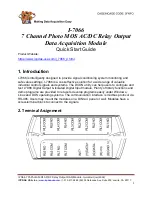
Clicking on one of the voltmeter icons will bring you to the setup page for that particular
voltmeter.
Here you can enter setup information like a name and notes for this voltmeter. The
precision box is used to set how many decimal places to display, valid choices are
between 2 and 6. The adjustment box is used to fine tune the voltmeter to match your DVM
reading. The Polarity Filter will allow both positive and negative, positive only, or negative only
readings. The Averaging Filter is used to smooth out the voltage readings. The “Suppress
Trigger Actions on Boot” check box is used to stop actions from happening when the
RMS-200 board is warm or cold started. Each voltmeter has a High, Normal, and Low
trigger range. Each High and Low trigger range has a maximum and minimum value. The
range in between the maximum and minimum value acts like a dead band area. Triggers
can be set to fire alerts or scripts when the voltage is either too high or too low. The High
Trigger is used when the voltage rises above the High Trigger maximum value. The
Normal Trigger is used when the voltage falls below the High Trigger minimum value. The
“Test Every” box is used to select how often the condition should be tested and acted
upon. Each voltmeter trigger can also execute a custom file stored on the RMS-200
board.
Summary of Contents for RMS-200
Page 1: ...RMS 200 C EtherTek Circuits...
Page 2: ...O w n e r s M a n u a l...
Page 48: ...Block Diagram...
















































